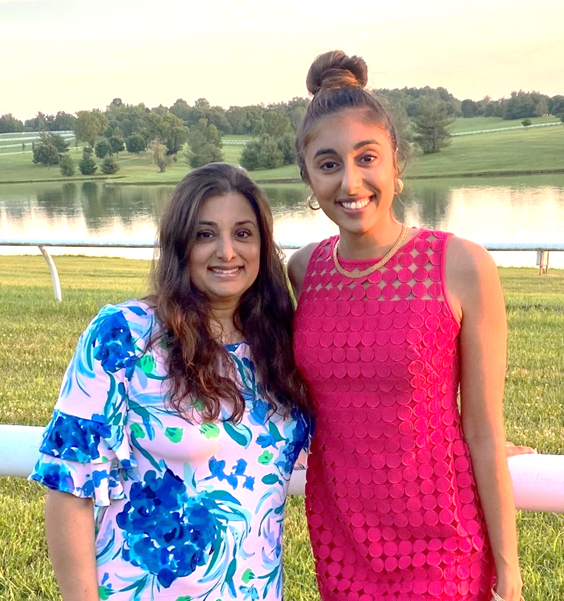Inside Tanium: An Employee Dedicated to Helping Customers Get More Value With Tanium
If you’ve ever spent much time reading software technical documentation, you’ll realize much of it’s pretty bad. Unless it’s been written by Sajida’s team.

Sajida DiAugustine (left) with her daughter at a horse farm in Kentucky.
Technical writers prepare instruction manuals, how-to guides and other supporting documents to communicate complex and technical information more easily to software users.
When Tanium’s Manager of Technical Documentation Sajida DiAugustine joined the company in 2015, she already had 25 years of technical writing experience after graduating from the University of Kentucky with a degree in English.
She learned the technical writing ropes in stints with Cisco, HP, and a large military contractor as well as by running her own technical writing business with clients like IBM, Valvoline and Lexmark.
We picked up her story after she was recruited as Tanium’s first technical writer.
Sajida DiAugustine: Tanium was a young company and growing fast. During the interview, they said they wanted me to grow a team and eventually become the documentation manager. It sounded like a great challenge. The year after I joined, we hired three writers, and now I have a team of 13.
So do you think technical writing is underappreciated at many tech companies?
Sajida DiAugustine: Definitely. I met Tanium’s VP of Engineering James Evans in my interview. James has a unique familiarity with technical writing because his grandfather started the undergraduate tech writing program at Brigham Young University. He understands the function of technical writing and the importance of documentation as an integral part of software development. You can build a great product, but if you don’t have the reference material to help customers use it, they can feel lost.
So, from the users’ perspective, what makes good documentation?
Sajida DiAugustine: It needs to be task-oriented. That’s how we organize our documentation on docs.tanium.com. We have sections at the beginning on what to do first and how to become immediately successful. Nobody wants to read a lengthy user guide.
The TAM organization is a huge audience for us because many customers have assigned TAMs who walk them through installation and initial tasks. Now, with the emphasis on customer self-service, our user guides are even more important. Information must be easy to find.
Where do you think most technical documentation fails?
Sajida DiAugustine: Tanium is the only place I’ve worked where user guides are actually read and used. I think technical documentation fails when it just goes menu by menu. For example, in a user guide for word processing software, you probably don’t want to discuss “page setup” or “how to create a TOC” first. You should go right to the main tasks people want to accomplish with the software, like “how to create a new document” or “how to format text”.
You’ve been able to make sure the technical writers you have are actually good writers, which is rare.
Sajida DiAugustine: It really is. It sometimes takes us six months to fill one spot. I feel as though everyone on my team is more knowledgeable and smarter than I am. There are things they do I’m sure many users don’t realize, like writing in a minimalist style. If something is very intuitive, we don’t explain it. We hire people who have a love for writing and for having accurate documentation that’s consistent.
You were initially hired as a tech writer, and now you lead the entire team. How has that changed your day-to-day life?
Sajida DiAugustine: Oh, it was crazy. I became documentation manager when I had six reports. Realistically, I think a writer can take on only three product modules max. So, even when I was the lead writer, I was still working on three modules. I felt like I was always behind. So when we hired the sixth writer, I gradually passed off the three modules I was responsible for.
How do you like working at Tanium compared with where you’ve worked before?
Sajida DiAugustine: I love it. I hope this is the last place I work. And, as I said, knowing our customers and that our TAM organization actually read our documents is so different from everywhere else I’ve worked, which makes the job especially rewarding.
Allowing people to be remote and work flexible hours, with unlimited paid time off (PTO) as long as you produce quality work, is really remarkable. I don’t think I’ve ever worked anywhere like Tanium.
What do you like to do with your free time?
Sajida DiAugustine: I’m an early riser. I do all my errands in the morning. At home, it’s just me and my German shepherd. My daughter lives about five minutes away.
And I’m working on a novel. My parents are from India. You won’t see a lot of people from India who came here in the ‘50s. And I was born here in the U.S. in 1967. Growing up in Lexington, Kentucky, no one had a clue where we were from. They’d heard of Native Americans but not of Asian Indians. Over the years, I was exposed to a lot of the Asian Indian immigrant experience. So, I have hilarious stories, where I’ve “changed the names to protect the innocent.”
What advice would you give a person trying to grow their career at Tanium?
Sajida DiAugustine: I think my main piece of advice is to learn about our products and processes. Tanium is unique. Get out of your comfort zone and meet with people on other teams you usually don’t collaborate with to learn as much as you can.
“Inside Tanium” is part of a series that highlights the people and culture of Tanium. To learn more about Tanium and explore our range of career opportunities, visit our Tanium Careers page.




